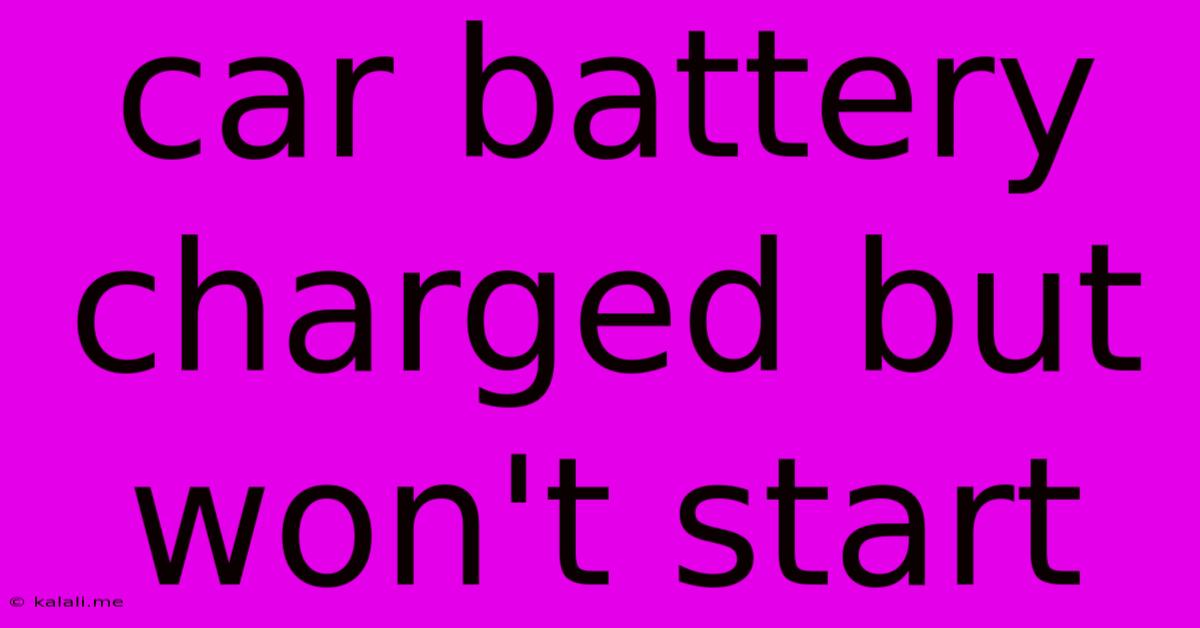Car Battery Charged But Won't Start
Kalali
Jun 07, 2025 · 3 min read

Table of Contents
Car Battery Charged But Won't Start: Troubleshooting Guide
Your car battery is fully charged, according to your charger, but your car still refuses to start? This frustrating situation points to a problem beyond a simple dead battery. This guide will help you troubleshoot the issue, walking you through common causes and solutions. Don't worry, you don't need to be a mechanic to figure this out!
What this article covers: We'll explore several reasons why your car might not start even with a fully charged battery, including issues with the starting system, battery terminals, parasitic drains, and more. We'll provide practical advice and DIY troubleshooting steps to help get you back on the road.
1. Check the Battery Terminals and Connections
Before diving into complex diagnostics, always start with the simplest checks. Corrosion on the battery terminals is a frequent culprit. A buildup of corrosion can prevent sufficient current flow, even with a fully charged battery.
- Visual Inspection: Carefully inspect both the positive (+) and negative (-) battery terminals for any signs of corrosion – a white, powdery substance.
- Cleaning the Terminals: If corrosion is present, disconnect the cables (negative first, then positive), and gently clean the terminals with a wire brush or terminal cleaner. A baking soda and water paste can also be effective. Reconnect the cables, ensuring a tight connection. Apply a small amount of dielectric grease to prevent future corrosion.
2. Test the Battery with a Multimeter
Even if your charger indicates a full charge, the battery might have internal damage or be failing. A multimeter provides a precise measurement of the battery's voltage.
- Voltage Test: With the engine off, connect the multimeter to the battery terminals. A healthy battery should read around 12.6 volts. Anything significantly lower suggests a problem with the battery itself, even if it recently charged. A reading below 12 volts under load is a stronger indication that your battery needs to be replaced.
3. Inspect the Starter Motor
The starter motor is responsible for cranking the engine. A faulty starter motor can prevent the car from starting even with a fully charged battery.
- Listen for Clicking: When you turn the key, do you hear a clicking sound? This often indicates a problem with the starter motor solenoid, a worn starter motor, or low voltage.
- Check Starter Motor Connections: Inspect the connections to the starter motor for corrosion or looseness. A bad connection can prevent the starter from receiving enough power.
4. Check the Alternator
While the alternator doesn't directly start the car, it's crucial for keeping the battery charged while the engine runs. A faulty alternator won't charge the battery properly, leading to repeated starting issues.
- Voltage Test with Running Engine: Start the engine and check the battery voltage again with the multimeter. It should read around 13.5 to 14.5 volts. A lower reading indicates a problem with the alternator.
5. Investigate Parasitic Drains
A parasitic drain occurs when an electrical component continues to draw power even when the car is off. This can slowly drain the battery overnight, rendering it unable to start the car in the morning, even after charging. This requires more advanced troubleshooting techniques, potentially involving a multimeter to identify the faulty component.
6. Consider Other Electrical Issues
Problems with the ignition switch, wiring harnesses, or other electrical components can also prevent the car from starting. These issues often require professional diagnosis and repair.
When to Seek Professional Help
If you've checked all these points and your car still won't start, it's best to seek professional help from a mechanic. They have the tools and expertise to diagnose more complex electrical problems. Remember safety first – always disconnect the negative battery terminal before performing any electrical checks.
Latest Posts
Latest Posts
-
How To Run In Windowed Mode On Epic Games Launcher
Jun 07, 2025
-
Get Into The Groove Of Things Meaning
Jun 07, 2025
-
Why Cant A Computer Use Analog
Jun 07, 2025
-
Can You Wash Drywall Mud Down Sink
Jun 07, 2025
-
How Do I Find Dungeons In Minecraft
Jun 07, 2025
Related Post
Thank you for visiting our website which covers about Car Battery Charged But Won't Start . We hope the information provided has been useful to you. Feel free to contact us if you have any questions or need further assistance. See you next time and don't miss to bookmark.